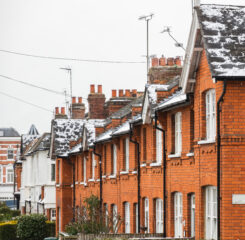HUD to Enforce Carbon Monoxide Protections in Affordable Housing
On January 31, 2022, HUD issued Notice H 2022-01 on carbon monoxide protections certain federally-subsidized housing. The Notice implements requirements from the HUD FY21 appropriations bill that HUD properties with a carbon monoxide source, such as an attached garages and certain appliances, install carbon monoxide alarms or detectors per International Fire Code standards.
Although HUD encourages properties to install carbon monoxide detection devices as soon as possible, the requirement will be enforced beginning December 27, 2022. The new requirement applies to all Housing Choice Voucher units and all Public Housing, Project Based Voucher, Project Based Rental Assistance, Section 202, and Section 811 properties with fire-fueled or fire-burning appliances or an attached garage.
The Notice reads: “HUD recognizes CO poisoning as an important safety issue for families in assisted housing…each year, more than 400 Americans die from unintentional CO poisoning not linked to fires, more than 20,000 visit the emergency room, and more than 4,000 are hospitalized.”
CO is an odorless, colorless, and toxic gas produced by malfunctioning combustion of fuel in vehicles, stoves, lanterns, grills, fireplaces, gas ranges, furnaces, and similar appliances; CO detection is not a replacement for proper installation and maintenance of appliances, or of appropriate ventilation in garages.
The Notice follows a tragic season of fire and smoke damage in HUD-assisted properties that have resulted in death and injury among residents, putting HUD in the spotlight to improve safety conditions in affordable housing.
Carbon Monoxide Detection
Among other standards, the IFC establishes minimum requirements for CO protections, which are periodically updated.
- Carbon Monoxide Alarm: A single or multiple station alarm intended to detect carbon monoxide gas and alert occupants by a distinct audible signal. It incorporates a sensor, control components and an alarm notification appliance in a single unit.
- Carbon Monoxide Detector: A device with an integral sensor to detect carbon monoxide gas and transmit an alarm signal to a connected alarm control unit.
HUD’s January 31 Notice requires housing providers to install CO detection in line with International Fire Code (IFC) 2018 standards, which are outlined in Chapter 9 (fire protections and life safety systems) and Chapter 11 (construction requirements for existing buildings) of the IFC.
Owners of properties receiving assistance through the PBRA, Section 202, and/or Section 811 program may utilize the property’s reserve for replacement account, residual receipts, general operating reserves, owner contributions, or secondary financing to fund the purchase, installation, and maintenance of CO alarms and detectors. These expenditures may be subject to a standard approval process where applicable, but the purchase, installation, and maintenance of CO alarms and detectors are deemed eligible expenses.
Prevention Strategies and Resident Education
Many LeadingAge housing providers have already installed CO protection devices for the health and safety of residents, and many housing communities are subject to CO detectors requirements in state or local law, code, or other regulation.
“Rental property owners, managers, and residents all play an important role in preventing CO intrusion and responding quickly when it occurs and where sources of CO exist,” reads HUD’s January 31 Notice.
HUD Notice H 2022-01 also describes examples of activities to prevent CO intrusion, and outlines sources of CO that can be found in a housing environment based on the Environmental Protection Agency’s (EPA) description of indoor air quality. The Notice also encourages housing providers to inform residents of CO risks and provide examples of CO avoidance. The Notice also states that HUD will develop additional CO materials for property management to support educational activities.
Data Collection and Enforcement
The FY21 appropriations bill required certain HUD housing to install operational carbon monoxide (CO) alarms or detectors within two years of the bill’s enactment on December 27, 2020. While HUD encourages PHAs and owners to adopt standards at or above the standards of the 2018 IFC as soon as possible, but will begin enforcement (December 27, 2022).
In 2019, HUD’s Real Estate Assessment Center (REAC) had issued Inspector Notice No. 2019-01 requiring inspectors to collect data on the presence of CO detectors in HUD-assisted properties. The data was collected as part of regular physical inspections and was not scored; HUD’s NSPIRE program, which will replace current physical inspection standards once fully rolled out, includes a scored Carbon Monoxide detection requirement.
Shortly after the Inspector Notice from 2019, HUD issued Notice H 2019-05 strongly encouraging housing providers to install CO detection systems.
Following the January 31 Notice of enforcement, LeadingAge has asked for insight from REAC about the data collected over the three years since the Inspector Notice, and to clarify how HUD intends to enforce the presence of CO detectors or alarms beginning December 27.

Most Recommended
October 15, 2025
 Shutdown Week Three: Impact of Ongoing Closure on Affordable Housing
Shutdown Week Three: Impact of Ongoing Closure on Affordable Housing
October 30, 2025
Fiscal Year (FY) Funding 2026
October 07, 2025
Immigrant Workforce Matching Program Brings Workforce Relief
Recently Added
October 30, 2025
 Shutdown: Older Adults' Access to Energy Assistance Under Threat
Shutdown: Older Adults' Access to Energy Assistance Under Threat
October 29, 2025
Medicare Advantage Takes Center Stage on John Oliver HBO Show
October 29, 2025



